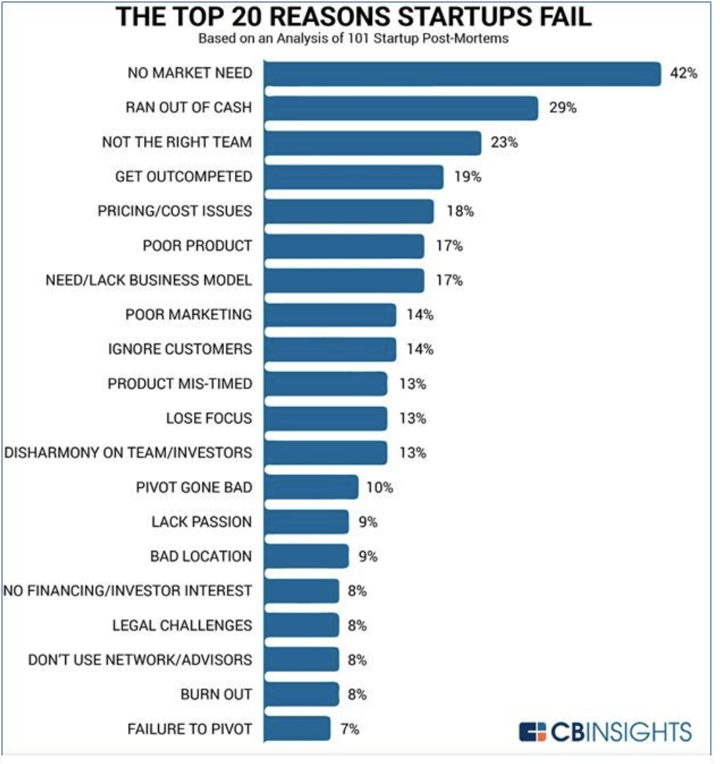
This blog originally posted on LinkedIn July 1, 2021
Small Business Innovation Research grants are non-dilutive Federal awards for startups inventing novel technology. The goal is to move early-stage tech to proof of concept, after which the company can seek more traditional investment. Eleven Federal Agencies participate in the program, and it is credited with huge ROI and launching an array of companies from Biogen to Qualcomm. An initial ‘Phase I’ award is typically small, on the order of $200k. If that goes well, applicants can apply for a follow-on ‘Phase II’ which is typically on the order of $1M. To win an award, the small business writes a proposal, which is reviewed by a group of technical experts. The scientific panel picks the winners.
A few months ago, I was putting together a webinar about successful commercialization from SBIR grants (called “Phase III”) when I made this lovely slide using data from the Air Force, Navy, and the National Cancer Institute:

Figure 1: SBIR Commercialization rates (Phase III) from three Branches
In Figure 1 column 2, the table is showing commercialization rates (Phase III rates) as reported from these three federal Branches who did in-depth studies. Each hired an independent firm to track down past awardees and figure out what happened via surveys and phone calls. It struck me that these are great transition rates. If you consider that 35-65% of Phase I awardees get to Phase II, that means that firms awarded a Phase I have about a 25% chance of making it. Note - Phase I’s generally fund unproven tough tech. Often they are paper studies. Those review panels do a great job! Let’s take a closer look:
Table I: Odds that SBIR Phase I technology will be successfully commercialized

For the AF and Navy, I put a discounted Commercialization Rate in parenthesis, since it seems they were counting 27% that were “follow on R&D” and “other” as Phase III, per the Figure 1 pie chart. Let’s assume those firms went out of business, or never scaled. That’s ok. Even if we take the lower value, the average across the three branches is 26%. According to a 2012 paper by Shakir Ghosh of Harvard Business School, that rate is the same as that for VC backed firms! Although, yes, some apples and oranges here. More on that later.
So, I wonder, why? Why do SBIR Phase I awardees do as well with commercialization as VC backed firms?
First, let’s assume that SBIR proposal reviewers and VCs are equally smart. Reviewers are successful scientists, and VCs are successful business people – high IQs all around. And for the sake of argument let’s assume the small companies get comparable monetary and advisory support, although the levels and models are very different for SBIR and VC.
To figure out why SBIR-awarded and VC-backed firms have similar success rates, I looked at some briefs on why startups fail and succeed. Many of you will recognize these lists of ‘what went wrong’ and ‘what went right’ :

Figure 2: The many failure modes of startups (Source: CB Insights). Note that the percentages add up to about 300%.

Figure 2 illustrates how hard it is to see failure coming – gee, there are so many ways it can happen. However, it shares mostly later-stage issues which are not considered in SBIR Phase I proposals, like team disharmony and failure to pivot, so it's not that applicable to our question at hand. That said, I think SBIR reviewers will have a pretty good handle on market need (top reason for failure), because the scientific community has a pulse on the innovations and drivers in their field -- the “significance” of the invention. The VC community does as well, due to deal flow and birds-eye view. Choosing teams with significant innovation can help get that 26% success rate. But the SBIR’s process cannot predict much about the other factors that contribute to failure. So, let's look at the other side of the coin: success factors.
Figure 3 shares 5 key factors for success: timing, team, truth/innovation, business model, and funding. Seems to me VCs are savvy about all five factors, while SBIR reviewers can only sort out the top three: timing, team, and truth. The timing and truth (significance) gets at the SBIR reviewers’ bleeding-edge know-how: is this a hot topic enabled by the latest stuff, and is the team’s insight a true innovation? With regard to team, generally only very accomplished scientists and engineers win SBIR awards (e.g University spinouts), so the technical team is almost always strong. SBIR funding Agencies also look for incubator participation and encourage iCorps and other programs to help awardees become true business people. (Although VCs have a huge advantage with Team as they meet them in person before funding.) As for item 4, the business model, it’s important in an SBIR application, but hard to assess when the idea is so early stage. Applicants think they can sell it, but they haven’t even made it yet. So, who knows. (VC’s have an advantage here since they can wait until after some early sales and traction.) As for item 5, funding, while SBIR’s offer priceless non-dilutive dollars for startups, it’s not really enough for scaling.
But if SBIR reviewers are only good at items 1-3, and generally fund tough-tech at riskier early stages, how is it they are able predict/achieve VC-like commercialization rates? I suspect it has to do with the apples and oranges of my comparison:
- SBIR’s are limited to technical innovations and don't include business plan innovations or consumer plays. (Novel battery? Sure. Uber? Not eligible.) So they are not as exposed to the added market variance, whimsy, and competition that comes with those spaces.
- SBIR funders don’t need big wins. It’s ok for the innovation to result in niche company, especially if you are solving a grave medical, military, or environmental need. So, Agencies get to put SBIR money on great ideas with only ok market sizes.
- Some SBIR firms are not true startups - they are a little further along and have some ballast. The SBIR is used to make a pivot or enter a new vertical.
What I’d really like to know is – what is the success rate of firms that got *both* an SBIR Phase I and VC investment? Things to think about!
###
photo credit: GETTY IMAGES (Z_WEI)
